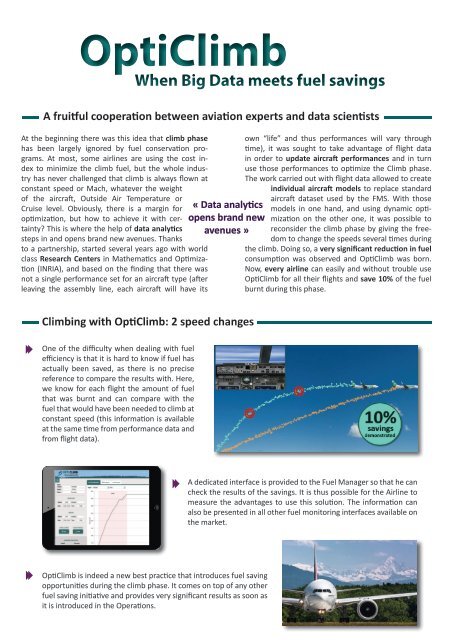OPTI CLIMB
1YLf2KK
1YLf2KK
You also want an ePaper? Increase the reach of your titles
YUMPU automatically turns print PDFs into web optimized ePapers that Google loves.
OptiClimb<br />
At the beginning there was this idea that climb phase<br />
has been largely ignored by fuel conservation programs.<br />
At most, some airlines are using the cost index<br />
to minimize the climb fuel, but the whole industry<br />
has never challenged that climb is always flown at<br />
constant speed or Mach, whatever the weight<br />
of the aircraft, Outside Air Temperature or<br />
Cruise level. Obviously, there is a margin for<br />
optimization, but how to achieve it with certainty?<br />
This is where the help of data analytics<br />
steps in and opens brand new avenues. Thanks<br />
to a partnership, started several years ago with world<br />
class Research Centers in Mathematics and Optimization<br />
(INRIA), and based on the finding that there was<br />
not a single performance set for an aircraft type (after<br />
leaving the assembly line, each aircraft will have its<br />
When Big Data meets fuel savings<br />
A fruitful cooperation between aviation experts and data scientists<br />
« Data analytics<br />
opens brand new<br />
avenues »<br />
own “life” and thus performances will vary through<br />
time), it was sought to take advantage of flight data<br />
in order to update aircraft performances and in turn<br />
use those performances to optimize the Climb phase.<br />
The work carried out with flight data allowed to create<br />
individual aircraft models to replace standard<br />
aircraft dataset used by the FMS. With those<br />
models in one hand, and using dynamic optimization<br />
on the other one, it was possible to<br />
reconsider the climb phase by giving the freedom<br />
to change the speeds several times during<br />
the climb. Doing so, a very significant reduction in fuel<br />
consumption was observed and OptiClimb was born.<br />
Now, every airline can easily and without trouble use<br />
OptiClimb for all their flights and save 10% of the fuel<br />
burnt during this phase.<br />
Climbing with OptiClimb: 2 speed changes<br />
One of the difficulty when dealing with fuel<br />
efficiency is that it is hard to know if fuel has<br />
actually been saved, as there is no precise<br />
reference to compare the results with. Here,<br />
we know for each flight the amount of fuel<br />
that was burnt and can compare with the<br />
fuel that would have been needed to climb at<br />
constant speed (this information is available<br />
at the same time from performance data and<br />
from flight data).<br />
A dedicated interface is provided to the Fuel Manager so that he can<br />
check the results of the savings. It is thus possible for the Airline to<br />
measure the advantages to use this solution. The information can<br />
also be presented in all other fuel monitoring interfaces available on<br />
the market.<br />
OptiClimb is indeed a new best practice that introduces fuel saving<br />
opportunities during the climb phase. It comes on top of any other<br />
fuel saving initiative and provides very significant results as soon as<br />
it is introduced in the Operations.


